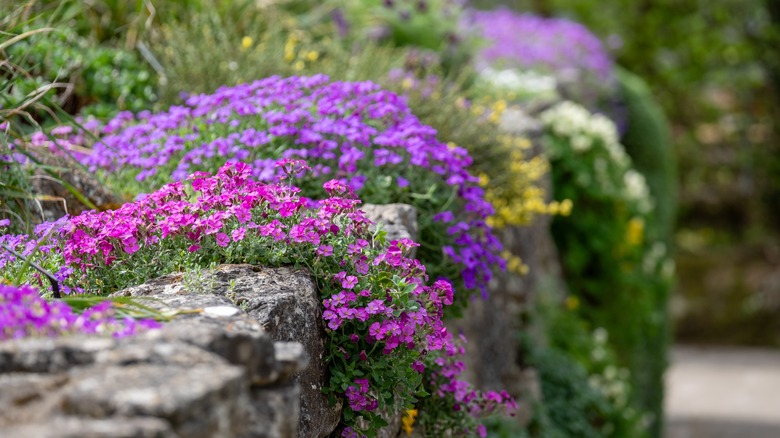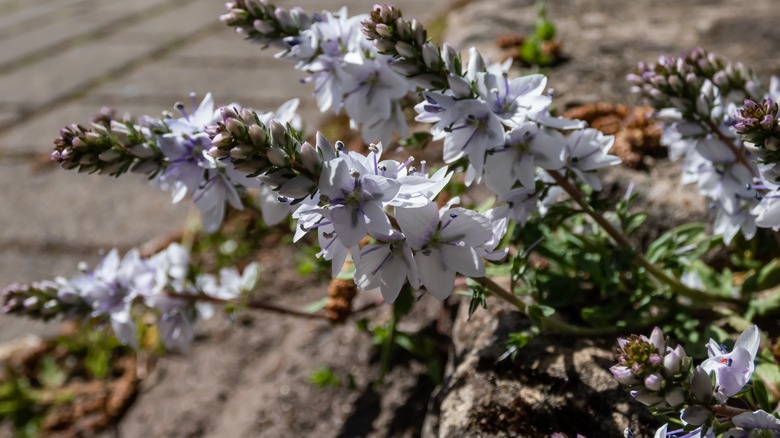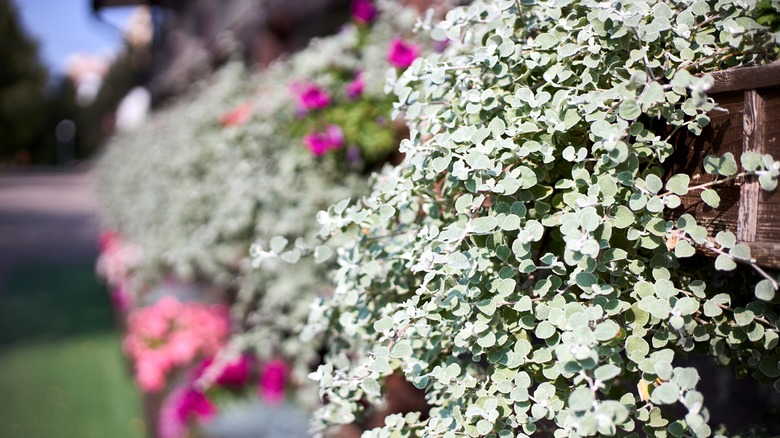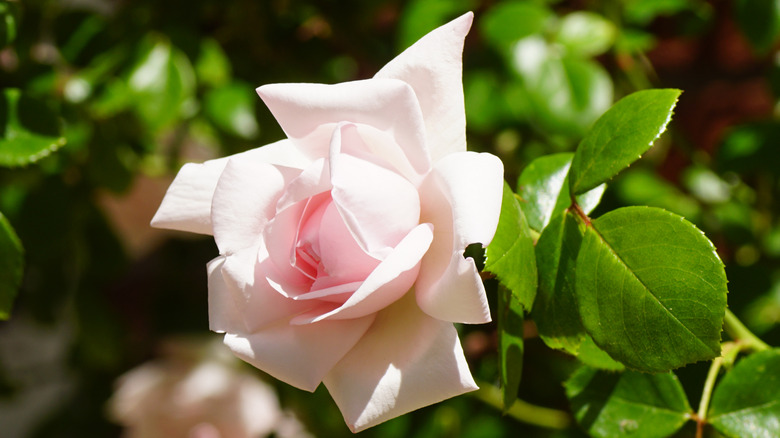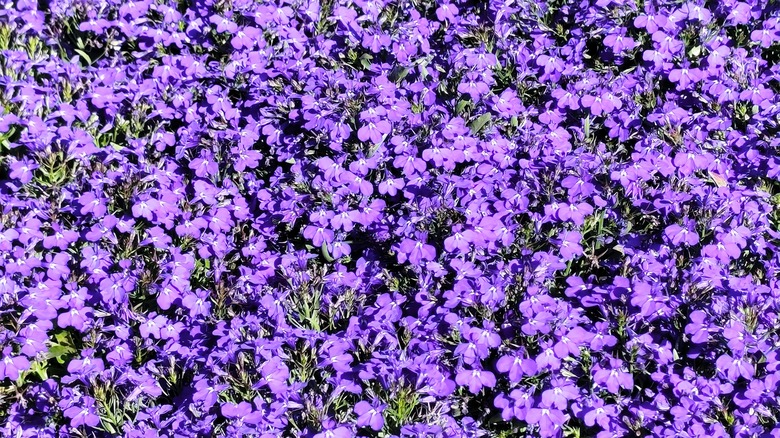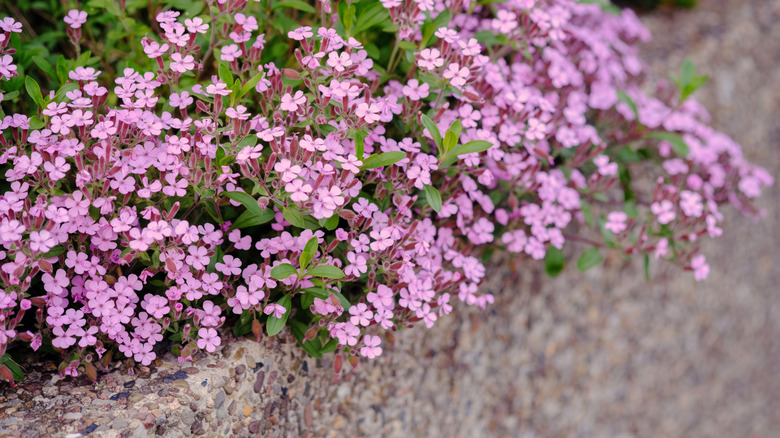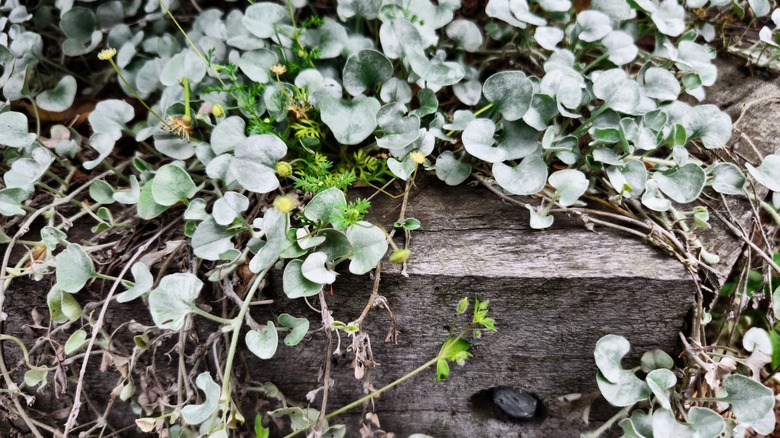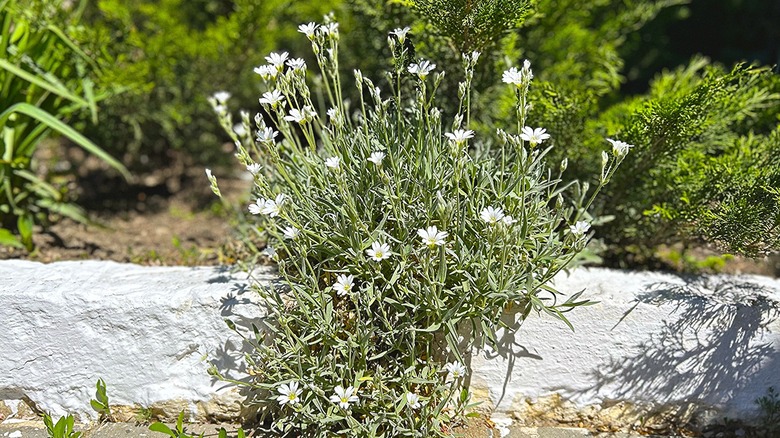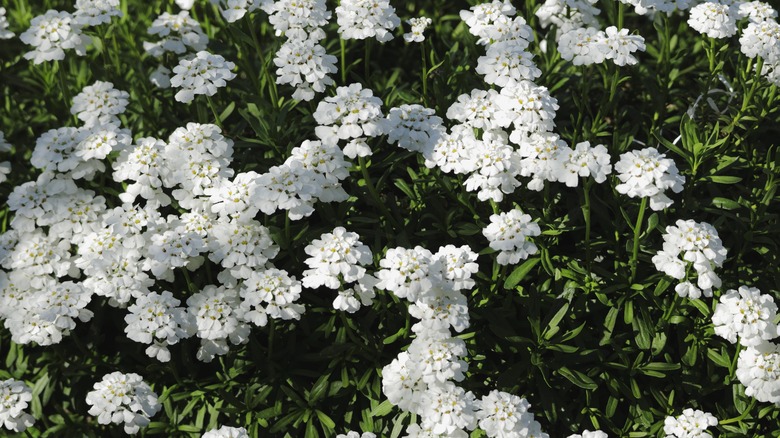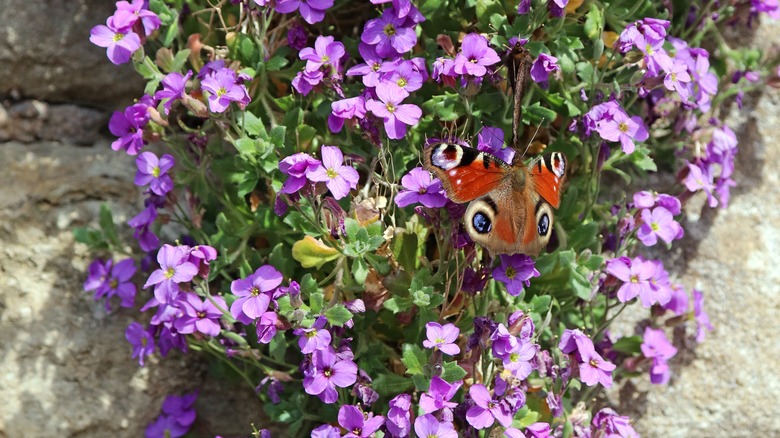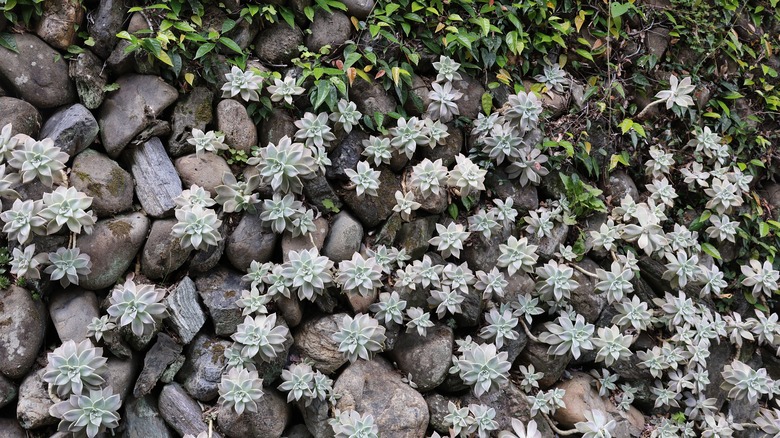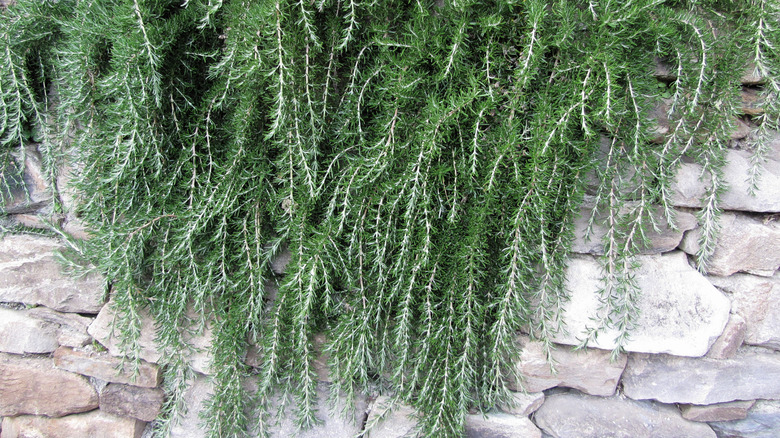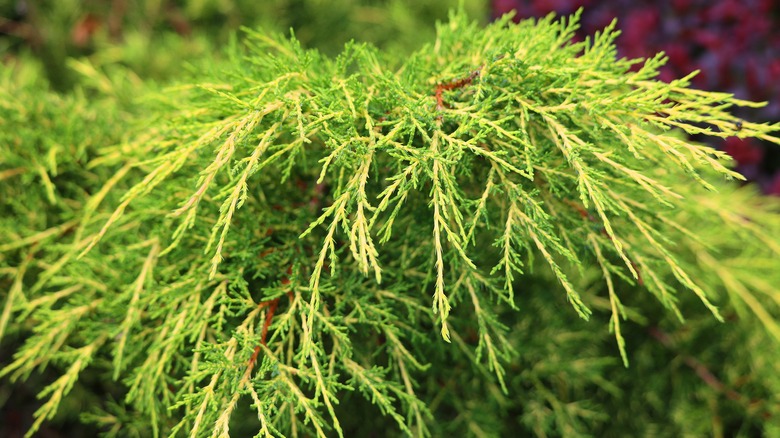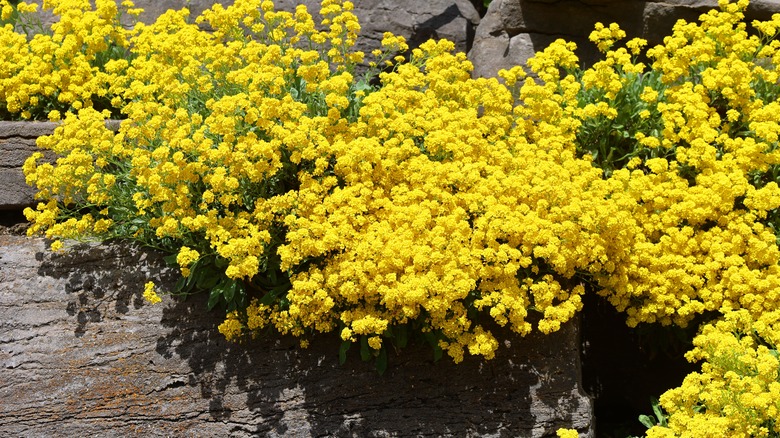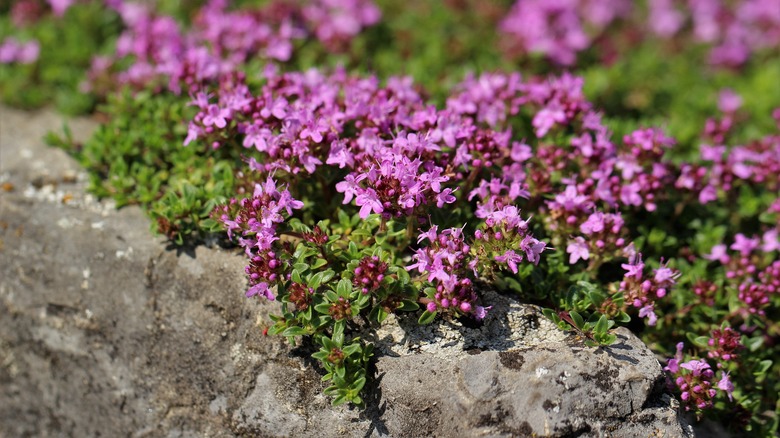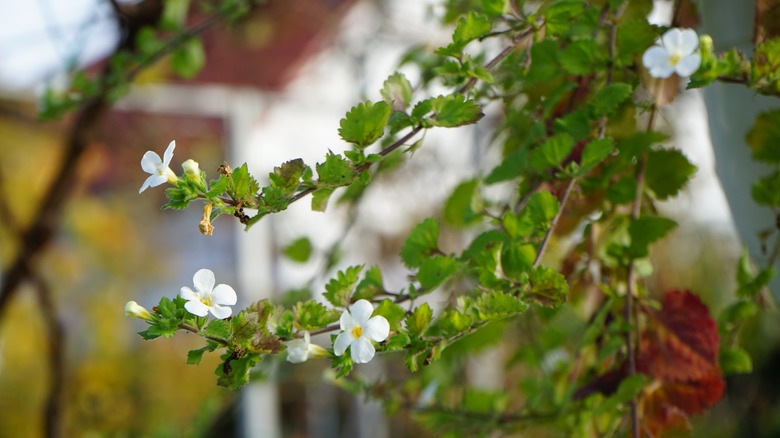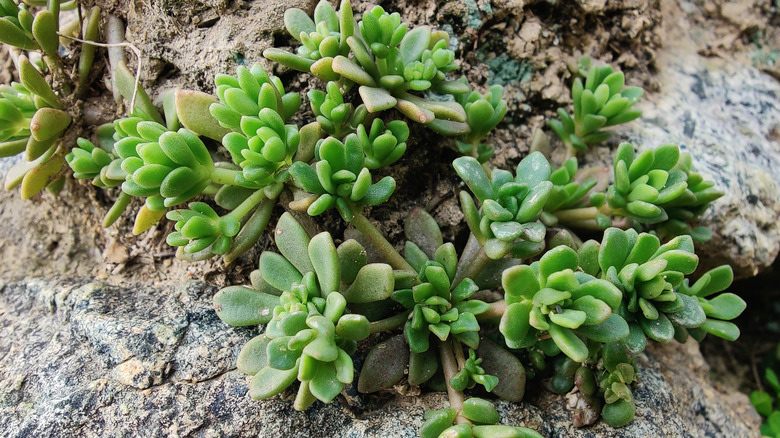16 Beautiful Plants That Will Happily Spill Over Your Retaining Wall
In the yard, a retaining wall serves a very simple purpose: to hold soil back to better utilize the terrain. From foot-high garden borders to towering walls that enclose an entire property, retaining walls come in a range of sizes and can be made from numerous materials like wood, stone, or brick. A well-constructed retaining wall has its own rustic beauty, but any wall in the garden can be enhanced by covering it with climbing and creeping plants that will cascade down the side.
Stuffing hardy succulents into the cracks of a retaining wall or lining the top with immense shrubs that will spill down is a quick way to give your property some overgrown charm. The category of naturally cascading plants is vast, and includes beautiful entries like candytuft and purple rock cress. Many trailing plants are also low maintenance, so even a novice gardener can adorn the ledges of their property with an array of luscious, dangling foliage. And while many of these plants would look just as nice in a hanging pot or window box, letting them cascade down a retaining wall will likely make the biggest statement.
Creeping veronica
Veronica prostrata, also known as creeping veronica or prostrate speedwell, is a lovely ground cover that can also add a soft rug of bluish purple or white flowers and spiky foliage to retaining walls. Hardy through USDA zones 4 to 8, this perennial thrives in full sun and well-drained soil. It will eventually form a mat of blooms that are so durable they'll keep growing after being stepped on. Creeping veronica is easy to grow but not aggressive, so you can use it to fill empty vertical and horizontal spaces without worrying about it damaging your other plants.
Licorice plant
With its soft, silver-dusted leaves, the licorice plant (Helichrysum petiolare) can add visual texture to many garden structures like walls and hanging flower pots. It's native to South Africa and thrives in the warmth of hardiness zones 9 to 11, where it grows as a drought-tolerant annual. The licorice plant is versatile — it requires minimal water, grows in sun or partial shade, and can even withstand low-quality soil. However, this tenacious species spreads rapidly and is considered an invasive species in California, so don't grow it in this state, and keep your pruning shears handy when dealing with the licorice plant.
'New Dawn' rose
Rosa 'New Dawn' is a climbing rose with broad, pale pink petals and strong stems that help it soar to over 10 feet in length. While technically a shrub, 'New Dawn' grows best with the support of a wall or trellis, or it can trail over walls. When planted in perpetually moist, loamy soil and given frequent waterings, these roses grow hardy in zones 5 through 9. The 'New Dawn' rose not only looks amazing, it smells good too, creating an aromatic wall when poised to grow over a garden wall or raised bed.
Trailing lobelia
Trailing lobelia (Lobelia erinus) is a delicately stemmed perennial with vibrant violet flowers that will cascade effortlessly over any raised edge. Despite its graceful appearance, lobelia isn't picky about soil types in hardiness zones 9 to 11, so long as the dirt is loose and won't become waterlogged. The plant can also deal with either full or partial sun, though it does require regular watering to keep the soil moist. Since it's a smaller plant, trailing lobelia is a good choice for filling in compact spaces above a retaining wall.
Rock soapwort
Especially versatile and hardy in zones 2 to 9, Saponaria ocymoides, or rock soapwort, is another mat-forming plant that will create a waterfall of blooms when planted on the edge of a vertical surface. Even though rock soapwort could easily grow into a carpet of tiny pink flowers, it is a fragile plant that won't recover from being stepped on, so draping it over a garden wall might actually be preferable. Once established in alkaline-leaning, well-draining soil, the soapwort will be drought-tolerant and able to withstand hours of direct sunlight.
Dichondra 'Silver Falls'
All you need to know about the looks of 'Silver Falls' (Dichondra argentea) is in its name: with its wide, silver, glistening leaves and elegant trailing growth pattern, this plant variety will provide a great contrast to boldly colored flowers and is a must-have for any retaining wall that could use a touch of opulence. The vine is also very tough; it's heat- and drought-tolerant throughout hardiness zones 8 to 12. It prefers well-draining sandy or loamy soil, full sun, and a light sprinkle of water if it ever starts to wilt.
Snow-in-summer
Snow-in-summer (Cerastium tomentosum) gets its name from its bounty of round white blooms that can resemble a snowdrift over a mat of dusty green stems and leaves. It can grow in several soil conditions within zones 3 to 7 and would rather be dry than watered. In fact, snow-in-summer can quickly develop root rot if kept in overly damp soil, so be sure to use a well-draining mix if you don't live somewhere with mostly dry weather. These whimsical flowers can spread quickly and easily give a retaining wall a cozy, overgrown look.
Candytuft
The dainty white flowers of the candytuft plant (Iberis sempervirens) look a bit like snow-in-summer at first glance, but candytuft has sparser blooms and deeper green foliage. Best grown in hardiness zones 3 to 8, this drought-tolerant evergreen thrives in full, direct sunlight and starts to suffer in moist conditions. As with other plant varieties that tend to spread out, you may need to cut back candytuft from time to time, but since it isn't invasive, letting it grow uninhibited over a garden wall is a hassle-free way to get a stunning result.
Purple rock cress
When it comes to decorating a retaining wall or any other garden surface, it's hard to go wrong with any mat-forming plant, including purple rock cress (Aubrieta deltoidea). It has countless small purple flowers with sunny yellow centers and thick, succulent-like leaves. Bring purple rock cress to life in hardiness zones 4 to 8 by providing it with at least six hours of direct sunlight a day, well-draining soil, and enough water to keep it from drying out. As you might infer from its name, rock cress grows excellently along rocky terrain like natural walls or borders.
Ghost plant
Ghost plant's (Graptopetalum paraguayense) long, woody tendrils may look a little strange, but there's no reason to be afraid of this unique, durable succulent. It hails from Mexico and therefore thrives in hardiness zones 9 to 11. Drought- and heat-resistant, ghost plants require dry, rocky soil and minimal watering. Although Graptopetalum prefers the heat, it can still withstand the cold and is easy to maintain as a houseplant, perhaps draped over a shelf. With its star-shaped leaves and alien-like stalks, ghost plant is certain to make an impression wherever you plant it.
Trailing rosemary
Rosmarinus officinalis 'Prostratus', also known as trailing, creeping, or prostrate rosemary, is an edible herb that tastes (and smells!) as good as it looks. Trailing rosemary has the same fine, cylindrical leaves and occasional pale purple flowers as the more common variant of the species, but it has the added benefit of being able to grow over walls or containers. Rosemary is extremely low-maintenance and can be left in full sun with very little water after the initial growing season. To complete your hassle-free herb garden, check out the other herbs that can take the summer heat and thrive all summer.
Creeping juniper
Native to the northern United States, creeping juniper (Juniperus horizontalis) has far-reaching, rich green branches with evergreen foliage. This sun-loving shrub is hardy in zones 3 to 9 and grows best in dry, loose, slightly acidic soil. While not difficult to take care of, it's vital to meet this plant's care requirements since junipers in general are susceptible to disease. Proper care can help avoid these issues, as can looking for a disease-resistant cultivar like 'Blue Rug.' Maintaining a healthy creeping juniper will be worth it for the captivating cascade of green it will add to garden walls.
Basket-of-gold
Like many other cascading plants, basket-of-gold (Aurinia saxatilis) is drought-tolerant and comfortable in dry, loose soil. That's because some of these plants originate from rocky regions with soil that usually doesn't deal with much moisture. You don't have to live in the mountains to grow basket-of-gold, but it helps if you're within hardiness zones 3 to 7. With very little effort, this perennial can add an eye-catching pop of yellow to retaining walls. For inspiration, look to our recommendations for stone retaining walls that look amazing.
Creeping thyme
Creeping thyme (Thymus serpyllum) is completely edible, but it's not the same as the thyme you'd find in the grocery store. Still, creeping thyme is an easy-to-grow, charming, evergreen flower that's definitely worth considering to drape over a retaining wall. These compact, purple-pink flowers can flourish in dry soil of practically any quality throughout zones 4 to 9. They need more water than some other rocky climbers, but are nevertheless drought-tolerant. Whether grown over a slope, rock wall, or garden border, the gorgeous color and sharp, minty scent of creeping thyme are sure to impress.
Water hyssop
Bacopa monnieri, also called water hyssop or simply bacopa, stands out against many other cascading plants due to its semi-aquatic characteristics. Native to tropical regions of the U.S. like Florida and Hawai'i, water hyssop is hardy through zones 8 to 11 and prefers damp conditions. It needs full sun and constantly moist or wet soil, so it would do well planted on a wall retaining a pond or water feature. Water hyssop is considered invasive in parts of Asia and Europe, but if maintained properly in North America, there shouldn't be any issues.
Sedum
Many stonecrop (Sedum) varieties, such as Sedum divergens, are capable of draping luxuriously down a garden wall and are easily cared for to boot. When planted in a sunny spot with well-draining soil, sedum grows in hardiness zones 3 to 9. Whether you stick with one species of sedum or mix and match, the plant's telltale thick, fleshy leaves can add a variety of colors and textures to an otherwise plain retaining wall. Once you've covered any remaining walls or borders, next try installing sedum ground cover varieties to enjoy an entire yard full of stonecrop.
